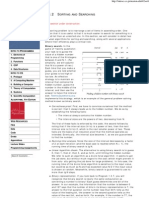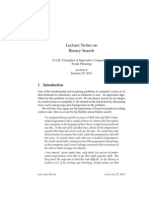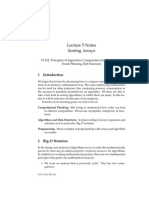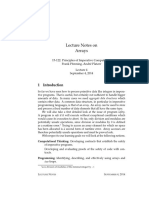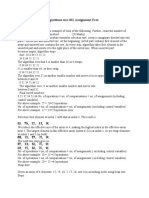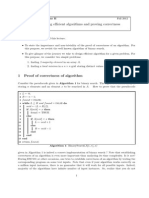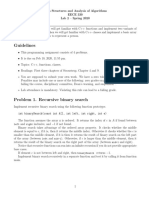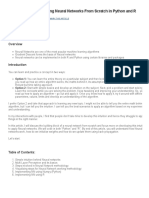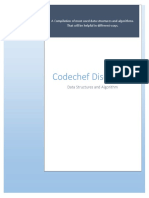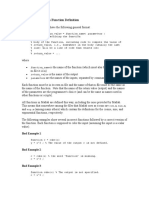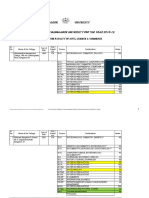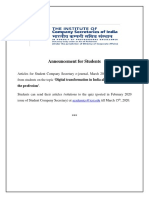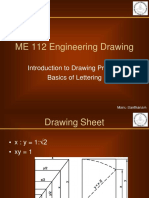Lecture Notes On Binary Search: 15-122: Principles of Imperative Computation Frank Pfenning August 31, 2010
Lecture Notes On Binary Search: 15-122: Principles of Imperative Computation Frank Pfenning August 31, 2010
Uploaded by
anuj tattiCopyright:
Available Formats
Lecture Notes On Binary Search: 15-122: Principles of Imperative Computation Frank Pfenning August 31, 2010
Lecture Notes On Binary Search: 15-122: Principles of Imperative Computation Frank Pfenning August 31, 2010
Uploaded by
anuj tattiOriginal Title
Copyright
Available Formats
Share this document
Did you find this document useful?
Is this content inappropriate?
Copyright:
Available Formats
Lecture Notes On Binary Search: 15-122: Principles of Imperative Computation Frank Pfenning August 31, 2010
Lecture Notes On Binary Search: 15-122: Principles of Imperative Computation Frank Pfenning August 31, 2010
Uploaded by
anuj tattiCopyright:
Available Formats
Lecture Notes on
Binary Search
15-122: Principles of Imperative Computation
Frank Pfenning
Lecture 3
August 31, 2010
1 Introduction
One of the fundamental and recurring problems in computer science is to
find elements in collections, such as elements in sets. An important algo-
rithm for this problem is binary search. We use binary search for an integer
in a sorted array to exemplify it.
Binary search is the first time we see the fundamental principle of divide-
and-conquer. We will see many other examples of this important principle
in future lectures. It refers to the idea of subdividing a given problem into
smaller components, each of which can be solved separately. We then com-
bine the results to obtain a solution to the original problem.
We will also once again see the importance of loop invariants in writing
correct code. Here is a note by Jon Bentley about binary search:
I’ve assigned [binary search] in courses at Bell Labs and IBM. Profes-
sional programmers had a couple of hours to convert [its] description
into a program in the language of their choice; a high-level pseudocode
was fine. At the end of the specified time, almost all the programmers
reported that they had correct code for the task. We would then take
thirty minutes to examine their code, which the programmers did with
test cases. In several classes and with over a hundred programmers,
the results varied little: ninety percent of the programmers found bugs
in their programs (and I wasn’t always convinced of the correctness of
the code in which no bugs were found).
I was amazed: given ample time, only about ten percent of profes-
sional programmers were able to get this small program right. But
L ECTURE N OTES A UGUST 31, 2010
Binary Search L3.2
they aren’t the only ones to find this task difficult: in the history in
Section 6.2.1 of his Sorting and Searching, Knuth points out that
while the first binary search was published in 1946, the first published
binary search without bugs did not appear until 1962.
—Jon Bentley, Programming Pearls (1st edition), pp.35–36
I contend that what these programmers are missing is the understanding
of how to use loop invariants in composing their programs. They help
us to make assumptions explicit and clarify the reasons why a particular
program is correct. Part of the magic of pre- and post-conditions as well as
loop invariants and assertions is that they localize reasoning. Rather than
having to look at the whole program, or the whole function, we can focus
on individual statements tracking properties via the loop invariants and
assertions.
Before we introduce binary search, we discuss linear search.
2 Linear Search in an Unsorted Array
If we are given an array of integers A without any further information and
have to decide if an element x is in A, we just have to search through it,
element by element. We return true as soon as we find an element that
equals x. If we have gone through the whole array and still not found such
an element, we return false.
bool is_in(int x, int[] A, int n)
//@requires 0 <= n && n <= \length(A);
{ int i;
for (i = 0; i < n; i++)
//@loop_invariant 0 <= i && i <= n;
if (A[i] == x) return true;
return false;
}
Could we strengthen the loop invariant, or write a postcondition? For
the loop invariant, we might want to express that x is not in A[0] . . . A[i−1].
We would have to express this with something like
//@loop_invariant !is_in(x, A, i);
where !b is the negation of b. However, it is difficult to make sense of this
because it uses is_in, which is the very function we are defining!
L ECTURE N OTES A UGUST 31, 2010
Binary Search L3.3
This is small illustration of the general observation that some functions
are basic specifications and are themselves not subject to further specifica-
tion. Because such basic specifications are generally very inefficient, they
are mostly used in other specifications (that is, pre- or post-conditions, loop
invariants, general assertions) rather than in code intended to be executed.
3 Sorted Arrays
A number of algorithms on arrays would like to assume that they are sorted.
We begin with a specification of this property. The function is_sorted(A,n)
traverses the array A from left to right, checking that each element is smaller
or equal to its right neighbor. We need to be careful about the loop invari-
ant to guarantee that there will be no attempt to access a memory element
out of bounds.
bool is_sorted(int[] A, int n)
//@requires 0 <= n && n <= \length(A);
{ int i;
for (i = 0; i < n-1; i++)
//@loop_invariant n == 0 || (0 <= i && i <= n-1);
if (!(A[i] <= A[i+1])) return false;
return true;
}
The loop invariant here is a disjunction: either n = 0 or i is between 0 and
n − 1. This is a simple or on boolean values (true and false) and not an
exclusive or, even though we will often pronounce it as either . . . or . . ..
Why is it necessary? If we ask if a zero-length array is sorted, then
before the check the exit condition of the loop the first time we have i = 0
and n = 0, so it is not the case that i ≤ n − 1. Therefore the second part of
the loop invariant does not hold. We account for that explicitly by allowing
n to be 0.
For an example of reasoning with loop invariants, we verify in some
detail why this is valid loop invariant.
Loop Entry: Upon loop entry, i = 0. We distinguish two cases. If n = 0,
then the left disjunction n == 0 holds. If n 6= 0 then n > 0 because
the precondition of the function requires n ≥ 0. But if n > 0 and i = 0
then i ≤ n − 1. We also have 0 ≤ i so 0 <= i && i <= n-1 holds.
L ECTURE N OTES A UGUST 31, 2010
Binary Search L3.4
Loop Traversal: Assume the loop invariant holds before the test, so either
n = 0 or 0 ≤ i ≤ n − 1. Because we do not exit the loop, we also have
i < n − 1. The step statement in the loop increments i so we have
i0 = i + 1.
Since i0 = i + 1 and 0 ≤ i we have 0 ≤ i0 . Also, since i < n − 1 and
i0 = i + 1 we have i0 − 1 < n − 1 and so i0 < n. Therefore i ≤ n − 1.
So 0 ≤ i0 ≤ n − 1 and the loop invariant is still satisfied because the
right disjunct is true for the new value i0 of i.
One pedantic point (and we do want to be pedantic in this class when
assessing function correctness, just like the machine is): from 0 ≤ i and
i0 = i + 1 we inferred 0 ≤ i0 . This is only justified in modular arithmetic if
we know that i + 1 does not overflow. Fortunately, we also know i < n − 1,
so i < n and i is bounded from above by a positive integer. Therefore
incrementing i cannot overflow.
We generally do not verify loop invariants in this amount of detail, but
it is important for you do know how to reason attentively through loop
invariants to uncover errors, be they in the program or in the loop invariant
itself.
4 Linear Search in a Sorted Array
Next, we want to search for an element x in an array A which we know is
sorted in ascending order. We want to return −1 if x is not in the array and
the index of the element if it is.
The pre- and postcondition as well as a first version of the function itself
are relatively easy to write.
int linsearch(int x, int[] A, int n)
//@requires 0 <= n && n <= \length(A);
//@requires is_sorted(A,n);
//@ensures (\result == -1 && !is_in(x, A, n)) || A[\result] == x;
{ int i;
for (i = 0; i < n; i++)
//@loop_invariant 0 <= i && i <= n;
if (A[i] == x) return i;
return -1;
}
L ECTURE N OTES A UGUST 31, 2010
Binary Search L3.5
This does not exploit that the array is sorted. We would like to exit the
loop and return −1 as soon as we find that A[i] > x. If we haven’t found x
already, we will not find it subsequently since all elements to the right of i
will be greater or equal to A[i] and therefore strictly greater than x. But we
have to be careful: the following program has a bug.
int linsearch(int x, int[] A, int n)
//@requires 0 <= n && n <= \length(A);
//@requires is_sorted(A,n);
//@ensures (\result == -1 && !is_in(x, A, n)) || A[\result] == x;
{ int i;
for (i = 0; A[i] <= x && i < n; i++)
//@loop_invariant 0 <= i && i <= n;
if (A[i] == x) return i;
return -1;
}
Can you spot the problem? If you cannot spot it immediately, reason
through the loop invariant. Read on if you are confident in your answer.
L ECTURE N OTES A UGUST 31, 2010
Binary Search L3.6
The problem is that the loop invariant only guarantees that 0 ≤ i ≤ n
before the exit condition is tested. So it is possible that i = n and the test
A[i] <= x will try access an array element out of bounds: the n elements
of A are numbered from 0 to n − 1.
We can solve this problem by taking advantage of the so-called short-
circuiting evaluation of the boolean operators of conjunction (“and”) && and
disjunction (“or”) ||. If we have condition e1 && e2 (e1 and e2 ) then we
do not attempt to evaluate e2 if e1 is false. This is because a conjunction
will always be false when the first conjunct is false, so the work would be
redundant.
Similarly, in a disjunction e1 || e2 (e1 or e2 ) we do not evaluate e2 if
e1 is true. This is because a disjunction will always be true when the first
disjunct it true, so the work would be redundant.
In our linear search program, we just swap the two conjuncts in the exit
test.
int linsearch(int x, int[] A, int n)
//@requires 0 <= n && n <= \length(A);
//@requires is_sorted(A,n);
//@ensures (\result == -1 && !is_in(x, A, n)) || A[\result] == x;
{ int i;
for (i = 0; i < n && A[i] <= x; i++)
//@loop_invariant 0 <= i && i <= n;
if (A[i] == x) return i;
return -1;
}
Now A[i] <= x will only be evaluated if i < n and the access will be in
bounds since we also know 0 ≤ i from the loop invariant.
This program is not yet satisfactory, because the loop invariant does not
have enough information to prove the postcondition. We do know that if we
return directly from inside the loop, that A[i] = x and so A[\result] == x
holds. But we cannot deduce that !is_in(x, A, n) if we return −1.
Before you read on, consider which loop invariant you might add to
guarantee that. Try to reason why the fact that the exit condition must
be false and the loop invariant true is enough information to know that
!is_in(x, A, n) holds.
L ECTURE N OTES A UGUST 31, 2010
Binary Search L3.7
Did you try to exploit that the array is sorted? If not, then your invariant
is most likely too weak, because the function is incorrect if the array is not
sorted!
What we want to say is that all elements in A to the left of index i are smaller
than x. Just saying A[i-1] < x isn’t quite right, because when the loop is
entered the first time we have i = 0 and we would try to access A[−1]. We
again exploit shirt-circuiting evaluation, this time for disjunction
int linsearch(int x, int[] A, int n)
//@requires 0 <= n && n <= \length(A);
//@requires is_sorted(A,n);
//@ensures (\result == -1 && !is_in(x, A, n)) || A[\result] == x;
{ int i;
for (i = 0; i < n && A[i] <= x; i++)
//@loop_invariant 0 <= i && i <= n;
//@loop_invariant i == 0 || A[i-1] < x;
if (A[i] == x) return i;
return -1;
}
It is easy to see that this invariant is preserved. Upon loop entry, i = 0.
Before we test the exit condition, we just incremented i. We did not return
while inside the loop, so A[i − 1] 6= x. Also, A[i − 1] ≤ x because the loop
condition was true on the prior iteration. From these two together we have
A[i − 1] < x.
Why does the loop invariant imply the postcondition of the function? If
we exit the loop normally, then the loop condition must be false. So either
i ≥ n or i < n and A[i] > x. In the first case, we know A[n−1] = A[i−1] < x.
Since the array is sorted, all elements from 0 to n − 1 are less or equal to
A[n − 1] and so also strictly less than x and x can not be in the array.
In the second case (A[i] > x) we also know from the loop invariant that
either i = 0 or A[i − 1] < x. Because the array is sorted, if A[0] > x then x
cannot be in the array. Also, again because the array is sorted, if A[i−1] < x
and A[i] > x then x cannot be in the array.
5 Analyzing the Number of Operations
In the worst case, linear search goes around the loop n times, where n is the
given bound. On each iteration except the last, we perform three compar-
isons: i < n, A[i] ≤ x and A[i] = x. Therefore, the number of comparisons
L ECTURE N OTES A UGUST 31, 2010
Binary Search L3.8
is almost exactly 3 ∗ n in the worst case. We can express this by saying that
the running time is linear in the size of the input (n). This allows us to pre-
dict the running time pretty accurately. We run it for some reasonably large
n and measure its time. Doubling the size of the input n0 = 2 ∗ n mean that
now we perform 3 ∗ n0 = 3 ∗ 2 ∗ n = 2 ∗ (3 ∗ n) operations, twice as many as
for n inputs.
We will introduce more abstract measurements for the running times in
the next lecture.
6 Binary Search
Can we do better than searching through the array linearly? If you don’t
know the answer already it might be surprising that, yes, we can do signif-
icantly better! Perhaps almost equally surprising is that the code is almost
as short!
Before we write the code, let us describe the algorithm. We start by
examining the middle element of the array. If it smaller than x than x must
be in the upper half of the array (if it is there at all); if is greater than x then
it must be in the lower half. Now we continue by restricting our attention
to either the upper or lower half, again finding the middle element and
proceeding as before.
We stop if we either find x, or if the size of the subarray shrinks to zero,
in which case x cannot be in the array.
Before we write a program to implement this algorithm, let us analyze
the running time. Assume for the moment that the size of the array is a
power of 2, say 2k . Each time around the loop, when we examine the mid-
dle element, we cut the size of the subarrays we look at in half. So before the
first iteration the size of the subarray of interest is 2k . After the second iter-
ation it is of size 2k−1 , then 2k−2 , etc. After k iterations it will be 2k−k = 1,
so we stop after the next iteration. Altogether we can have at most k + 1
iterations. Within each iteration, we perform a constant amount of work:
computing the midpoint, and a few comparisons. So, overall, when given
a size of array n we perform c ∗ log2 (n) operations.1
If the size n is not a power of 2, then we can round n up to the next
power of 2, and the reasoning above still applies. The actual number of
1
In general in computer science, we are mostly interested in logarithm to the base 2 so
we will just write log(n) for log to the base 2 from now on unless we are considering a
different base.
L ECTURE N OTES A UGUST 31, 2010
Binary Search L3.9
steps can only be smaller than this bound, because some of the actual subin-
tervals may be smaller than the bound we obtained when rounding up n.
The logarithm grows much slower than the linear function that we ob-
tained when analyzing linear search. As before, consider that we are dou-
bling the size of the input, n0 = 2 ∗ n. Then the number of operations will be
c ∗ log(2 ∗ n) = c ∗ (log(2) + log(n)) = c ∗ (1 + log(n)) = c + c ∗ log(n). So the
number of operations increases only by a constant amount c when we dou-
ble the size of the input. Considering that the largest representable positive
number in two’s complement representation is 231 − 1 (about 2 billion) bi-
nary search even for unreasonably large arrays will only traverse the loop
31 times! So the maximal number of operations is effectively bounded by a
constant if it is logarithmic.
L ECTURE N OTES A UGUST 31, 2010
Binary Search L3.10
7 Implementing Binary Search
The specification for binary search is the same as for linear search.
int binsearch(int x, int[] A, int n)
//@requires 0 <= n && n <= \length(A);
//@requires is_sorted(A,n);
//@ensures (\result == -1 && !is_in(x, A, n)) || A[\result] == x;
;
We have two variables, lower and upper, which hold the lower and upper
end of the subinterval in the array that we are considering. We start with
lower as 0 and upper as n, so the interval includes lower and excludes
upper. This often turns out to be a convenient choice when computing
with arrays.
The for loop from linear search becomes a while loop, exiting when
the interval has size zero, that is, lower == upper. We can easily write the
first loop invariant, relating lower and upper to each other and the overall
bound of the array.
int binsearch(int x, int[] A, int n)
//@requires 0 <= n && n <= \length(A);
//@requires is_sorted(A,n);
//@ensures (\result == -1 && !is_in(x, A, n)) || A[\result] == x;
{ int lower = 0;
int upper = n;
while (lower < upper)
//@loop_invariant 0 <= lower && lower <= upper && upper <= n;
{
// ...??...
}
return -1;
}
In the body of the loop, we first compute the midpoint mid. Then we
check if A[mid ] = x. If so, we have found the element and return mid .
int binsearch(int x, int[] A, int n)
//@requires 0 <= n && n <= \length(A);
//@requires is_sorted(A,n);
//@ensures (\result == -1 && !is_in(x, A, n)) || A[\result] == x;
L ECTURE N OTES A UGUST 31, 2010
Binary Search L3.11
{ int lower = 0;
int upper = n;
while (lower < upper)
//@loop_invariant 0 <= lower && lower <= upper && upper <= n;
//@loop_invariant ...??...
{ int mid = (lower + upper)/2;
if (A[mid] == x) return mid;
// ...??...
}
return -1;
}
Now comes the hard part. What is the missing part of the invariant?
The first instinct might be to say that x should be in the interval from
A[lower ] to A[upper ]. But that may not even be true when the loop is en-
tered the first time. Looking back at linear search we notice that the invari-
ant was somewhat different: we expressed that x could not be outside of
the chosen interval. We say that here by saying that A[lower − 1] < x and
A[upper ] > x. The asymmetry arises because the interval under considera-
tion includes A[lower ] but excludes A[upper ].
As in linear search, we have to worry about the boundary condition
when lower = 0 or upper = n, in which case we have not yet excluded any
part of the array. And, again, we use disjunction and exploit short-circuit
evaluation to put these together.
int binsearch(int x, int[] A, int n)
//@requires 0 <= n && n <= \length(A);
//@requires is_sorted(A,n);
//@ensures (\result == -1 && !is_in(x, A, n)) || A[\result] == x;
{ int lower = 0;
int upper = n;
while (lower < upper)
//@loop_invariant 0 <= lower && lower <= upper && upper <= n;
//@loop_invariant (lower == 0 || A[lower-1] < x);
//@loop_invariant (upper == n || A[upper] > x);
{ int mid = (lower+upper)/2;
if (A[mid] == x) return mid;
// ...??...
}
return -1;
}
L ECTURE N OTES A UGUST 31, 2010
Binary Search L3.12
At this point, let’s check if the loop invariant is strong enough to imply
the postcondition of the function. If we return from inside the loop because
A[mid ] = x we return mid , so A[\result] == x as required.
If we exit the loop because lower < upper is false, we know lower =
upper , by the first loop invariant. Now we have to distinguish some cases.
1. If A[lower −1] < x and A[upper ] > x, then A[lower ] > x (since lower =
upper ). Because the array is sorted, x cannot be in it.
2. If lower = 0, then upper = 0. By the second conjunct, then either
n = 0 (and so the array has no elements and we must return −1), or
A[upper ] = A[lower ] = A[0] > x. Because A is sorted, x cannot be in
A if its first element is already strictly greater than x.
3. If upper = n, then lower = n. By the first conjunct, then either n = 0
(and so we must return −1), or A[n − 1] = A[upper − 1] = A[lower −
1] < x. Because A is sorted, x cannot be in A if its last element is
already strictly less than x.
Notice that we could verify all this without even knowing the complete
program! As long as we can finish the loop to preserve the invariant and
terminate, we will have a correct implementation! This would again be a
good point for you to interrupt your reading and to try to complete the
loop, reasoning from the invariant.
L ECTURE N OTES A UGUST 31, 2010
Binary Search L3.13
We have already tested if A[mid ] = x. If not, then A[mid ] must be less or
greater than x. If it is less, then we can keep the upper end of the interval
as is, and set the lower end ot mid + 1. Now A[lower − 1] < x (because
A[mid ] < x and lower = mid + 1), and the condition on the upper end
remains unchanged.
If A[mid ] > x we can set upper to mid and keep lower the same. We
do not need to test this last condition, because the fact the tests A[mid ] = x
and A[mid ] < x both failed implies that A[mid ] > x. We note this in an
assertion.
int binsearch(int x, int[] A, int n)
//@requires 0 <= n && n <= \length(A);
//@requires is_sorted(A,n);
//@ensures (\result == -1 && !is_in(x, A, n)) || A[\result] == x;
{ int lower = 0;
int upper = n;
while (lower < upper)
//@loop_invariant 0 <= lower && lower <= upper && upper <= n;
//@loop_invariant (lower == 0 || A[lower-1] < x);
//@loop_invariant (upper == n || A[upper] > x);
{ int mid = (lower+upper)/2;
if (A[mid] == x) return mid;
else if (A[mid] < x) lower = mid+1;
else /*@assert(A[mid] > x);@*/ upper = mid;
}
return -1;
}
Does this function terminate? If proceed to the loop body, that is, lower <
upper , then the interval from lower to upper is non-empty. Moreover, the
intervals from lower to mid and from mid + 1 to upper are both strictly
smaller than the original interval. Unless we find the element, the differ-
ence between upper and lower must eventually become 0 and we exit the
loop.
8 One More Bug
The function so far, even though we “proved” it correct, still contains a bug.
Again, consider the function and see if you can spot the problem. Do not
give up too early!
L ECTURE N OTES A UGUST 31, 2010
Binary Search L3.14
Where you able to see it? It’s subtle, but somewhat similar to the prob-
lem we had in our very first example, the integer square root. Where we
compute
int mid = (lower + upper)/2;
we could actually have an overflow, if lower + upper > 231 − 1. This is
somewhat unlikely in practice, since 231 = 2G, about 2 billion, so the array
would have to have at least 1 billion elements. This is not impossible, and,
in fact, a bug like this in the Java libraries2 was actually exposed.
Fortunately, the fix is simple: because lower < upper , we know that
upper − lower > 0 and represents the size of the interval. So we can divide
that in half and add it to the lower end of the interval to get its midpoint.
int binsearch(int x, int[] A, int n)
//@requires 0 <= n && n <= \length(A);
//@requires is_sorted(A,n);
//@ensures (\result == -1 && !is_in(x, A, n)) || A[\result] == x;
{ int lower = 0;
int upper = n;
while (lower < upper)
//@loop_invariant 0 <= lower && lower <= upper && upper <= n;
//@loop_invariant (lower == 0 || A[lower-1] < x);
//@loop_invariant (upper == n || A[upper] > x);
{ int mid = lower + (upper-lower)/2; // (lower + upper)/2 could overflow
if (A[mid] == x) return mid;
else if (A[mid] < x) lower = mid+1;
else /*@assert(A[mid] > x);@*/ upper = mid;
}
return -1;
}
Other operations in this program take place on quantities bounded from
above by n and thus cannot overflow.
9 Some Measurements
Algorithm design is an interesting mix between mathematics and an ex-
perimental science. Our analysis above, albeit somewhat preliminary in
2
see Joshua Bloch’s Extra, Extra blog entry
L ECTURE N OTES A UGUST 31, 2010
Binary Search L3.15
nature, allow us to make some predictions of running times of our imple-
mentations. We start with linear search. We first set up a file to do some
experiments. We assume we have already tested our functions for correct-
ness, so only timing is at stage. See the file find-time.c0 on the course web
pages. We compile this file, together with the our implementation from this
lecture and a random number generator with the cc0 command below. We
can get an overall end-to-end timing with the Unix time command.
% cc0 -lconio rand.h0 lcg.c0 find.c0 find-time.c0
% time ./a.out
When running linear search 2000 times (1000 elements in the array and 1000
random elements) on 218 elements (256 K elements) we get the following
answer
Timing 1000 times with 2^18 elements
0
4.602u 0.015s 0:04.63 99.5% 0+0k 0+0io 0pf+0w
which indicates 4.602 seconds of user time.
Running linear search 2000 times on random arrays of size 218 , 219 and
220 we get the timings on our MacBook Pro
array size time (secs)
218 4.602
2 19 9.027
220 19.239
The running times are fairly close to doubling consistently. Due to mem-
ory locality effects and other overheads, for larger arrays we would expect
larger numbers.
Running the same experiments with binary search we get
array size time (secs)
218 0.020
2 19 0.039
220 0.077
which is much, much faster but looks suspicously linear as well.
Reconsidering the code we see that the time might increase linearly be-
cause we actually must iterate over the whole array in order to initialize it
with random elements!
L ECTURE N OTES A UGUST 31, 2010
Binary Search L3.16
We comment out the testing code to measure only the initialization
time, and we see that for 220 elements we measure 0.072 seconds, as com-
pared to 0.077 which is insignificant. Effectively, we have been measuring
the time to set up the random array, rather than to find elements in it with
binary search!
This is a vivid illustration of the power of divide-and-conquer. Loga-
rithmic running time for algorithms grow very slowly, a crucial difference
to linear-time algorithms when the data sizes become large.
L ECTURE N OTES A UGUST 31, 2010
You might also like
- HJL ManualDocument124 pagesHJL ManualSteve Bote100% (3)
- 06 BinsearchDocument15 pages06 BinsearchRajdip PalNo ratings yet
- 06 BinsearchDocument15 pages06 BinsearchaisahmNo ratings yet
- Sorting and SearchingDocument14 pagesSorting and Searchingabhijeetk3No ratings yet
- Binary SearchDocument12 pagesBinary SearchpetejuanNo ratings yet
- Asymptotic Analysis (Big-O Notation) : Big O Notation Is Used in Computer Science To Describe The PerformanceDocument10 pagesAsymptotic Analysis (Big-O Notation) : Big O Notation Is Used in Computer Science To Describe The PerformanceNavleen KaurNo ratings yet
- Lab Manual - CL1Document89 pagesLab Manual - CL1Joel D'cruzNo ratings yet
- Data Structure Module 1Document10 pagesData Structure Module 1ssreeram1312.tempNo ratings yet
- Dsa Live PDFDocument44 pagesDsa Live PDFJay Singh RajpootNo ratings yet
- Introduction To Algorithm Complexity: News About Me Links ContactDocument8 pagesIntroduction To Algorithm Complexity: News About Me Links Contactjay_prakash02No ratings yet
- Chapter 1: Introduction Algorithms and Conventions: What Is An Algorithm?Document6 pagesChapter 1: Introduction Algorithms and Conventions: What Is An Algorithm?nanisanjuNo ratings yet
- Is This The Simplest (And Most Surprising) Sorting Algorithm Ever?Document7 pagesIs This The Simplest (And Most Surprising) Sorting Algorithm Ever?Tim PaloNo ratings yet
- 05 SortDocument12 pages05 Sortderrickarenas14No ratings yet
- Chapter 3Document81 pagesChapter 3Aditya PandeyNo ratings yet
- Blaeser Algorithms and Data StructuresDocument109 pagesBlaeser Algorithms and Data StructuresMaia OsadzeNo ratings yet
- Basic Concepts in Algorithmic AnalysisDocument59 pagesBasic Concepts in Algorithmic Analysismastafe07No ratings yet
- Python 3Document122 pagesPython 3Nurlign YitbarekNo ratings yet
- Lecture Notes On Arrays: 15-122: Principles of Imperative Computation Frank Pfenning, Andr e Platzer September 4, 2014Document15 pagesLecture Notes On Arrays: 15-122: Principles of Imperative Computation Frank Pfenning, Andr e Platzer September 4, 2014Kunal SinghNo ratings yet
- Unit 5 Brute Force Method: StructureDocument20 pagesUnit 5 Brute Force Method: StructureRaj SinghNo ratings yet
- Design & Analysis of Algorithms Mcs 031 Assignment FreeDocument15 pagesDesign & Analysis of Algorithms Mcs 031 Assignment Freecutehacker22No ratings yet
- Dec 2016 Data StrcuturesDocument13 pagesDec 2016 Data Strcuturessaif shaikhNo ratings yet
- Lecture 4 CS210 2012 PDFDocument4 pagesLecture 4 CS210 2012 PDFMoazzam HussainNo ratings yet
- Quick Sort NotesDocument16 pagesQuick Sort NotesGhulam AliNo ratings yet
- Binary Search: Algorithm TutorialsDocument6 pagesBinary Search: Algorithm TutorialsPinkie PinkyNo ratings yet
- Laboration 1-Retur-1Document12 pagesLaboration 1-Retur-1joelwillnNo ratings yet
- Classification Algorithm: Supervised Learning Technique Training DataDocument28 pagesClassification Algorithm: Supervised Learning Technique Training Datamirahaem5No ratings yet
- DSA-U1-Notes 23-24Document33 pagesDSA-U1-Notes 23-24sanayi8288No ratings yet
- Fundamentals Deep Learning Activation Functions When To Use ThemDocument15 pagesFundamentals Deep Learning Activation Functions When To Use ThemfaisalNo ratings yet
- Lab2 PDFDocument3 pagesLab2 PDFKarima BabaNo ratings yet
- Unit1 DaaDocument21 pagesUnit1 DaaArunachalam SelvaNo ratings yet
- AI ExternalDocument23 pagesAI ExternalshrihariNo ratings yet
- DAA Unit 2Document41 pagesDAA Unit 2hari karanNo ratings yet
- Unit-I DAADocument25 pagesUnit-I DAAjassem alshaliliNo ratings yet
- Advanced Search On Linear Data Structures: Li Yin February 8, 2020Document17 pagesAdvanced Search On Linear Data Structures: Li Yin February 8, 2020markNo ratings yet
- Understanding and Coding Neural Networks From Scratch in Python and RDocument12 pagesUnderstanding and Coding Neural Networks From Scratch in Python and RKhương NguyễnNo ratings yet
- SEM5 - ADA - RMSE - Questions Solution1Document58 pagesSEM5 - ADA - RMSE - Questions Solution1DevanshuNo ratings yet
- CSPE 102 - Module 3Document19 pagesCSPE 102 - Module 3MC JERID C. BATUNGBAKALNo ratings yet
- ADS Unit - 1Document23 pagesADS Unit - 1Surya100% (1)
- AA0103C0102Document97 pagesAA0103C0102Jose Daniel Amador SalasNo ratings yet
- B.Tech Project Mid Term Report: Handwritten Digits Recognition Using Neural NetworksDocument13 pagesB.Tech Project Mid Term Report: Handwritten Digits Recognition Using Neural NetworksVandhana RathodNo ratings yet
- BTP Project ReportDocument13 pagesBTP Project ReportVandhana RathodNo ratings yet
- Data Structure - Chap 1Document42 pagesData Structure - Chap 1Elias KaramNo ratings yet
- Experiment 2 v2Document10 pagesExperiment 2 v2saeed wedyanNo ratings yet
- Chef Discussions in ProgrammingDocument516 pagesChef Discussions in ProgrammingClaire NegroNo ratings yet
- DAA InsemDocument17 pagesDAA InsemTanvi RainakNo ratings yet
- lecture19Document8 pageslecture19neraho1297No ratings yet
- Big O MIT PDFDocument9 pagesBig O MIT PDFJoanNo ratings yet
- AlgorithmDocument885 pagesAlgorithmash23ish100% (1)
- DAA Lab ManualDocument49 pagesDAA Lab ManualsammmNo ratings yet
- Python Unit 5 New 2020Document24 pagesPython Unit 5 New 2020devNo ratings yet
- Algorithmic Designing: Unit 1-1. Time and Space ComplexityDocument5 pagesAlgorithmic Designing: Unit 1-1. Time and Space ComplexityPratik KakaniNo ratings yet
- Objectives: A Problem Example 1Document5 pagesObjectives: A Problem Example 1iam_wilberNo ratings yet
- Functii de Activare1Document89 pagesFunctii de Activare1adrian IosifNo ratings yet
- Safeguarded Zero-Finding Methods: Sumanth Hegde and Saurav KaseraDocument19 pagesSafeguarded Zero-Finding Methods: Sumanth Hegde and Saurav KaseraDuy TùngNo ratings yet
- Introduction & Median Finding: 1.1 The CourseDocument8 pagesIntroduction & Median Finding: 1.1 The CourseRameeshPaulNo ratings yet
- Todo User-Defined Functions - Bad ExamplesDocument2 pagesTodo User-Defined Functions - Bad Examplesanuj tattiNo ratings yet
- List of BU Affiliated Colleges 2018 19Document80 pagesList of BU Affiliated Colleges 2018 19anuj tattiNo ratings yet
- Announcement For StudentsDocument1 pageAnnouncement For Studentsanuj tattiNo ratings yet
- Website ClassroomDocument2 pagesWebsite Classroomanuj tattiNo ratings yet
- Prasna MargaDocument1 pagePrasna Margaanuj tattiNo ratings yet
- List of BU Affiliated Colleges 2018 19Document80 pagesList of BU Affiliated Colleges 2018 19anuj tattiNo ratings yet
- Websiteclassroom PDFDocument2 pagesWebsiteclassroom PDFanuj tattiNo ratings yet
- Letter of Engagement: Kaustubh Dinesh NaikDocument2 pagesLetter of Engagement: Kaustubh Dinesh Naikanuj tattiNo ratings yet
- Relieving Letter: KARVY COMPUTERSHARE LIMITED/D.E.O/012018/326014 01 29, 2018Document1 pageRelieving Letter: KARVY COMPUTERSHARE LIMITED/D.E.O/012018/326014 01 29, 2018anuj tattiNo ratings yet
- Maharashtra State Board of Technical Education 008Document12 pagesMaharashtra State Board of Technical Education 008Siddhart KadamNo ratings yet
- Economics Assignment Group 5Document6 pagesEconomics Assignment Group 5Jaymeet PatilNo ratings yet
- Chapter 10 - Exotic Scales Chapter 10 - Exotic Scales Guitar Lesson 1 Guitar Lesson 1 FormulasDocument15 pagesChapter 10 - Exotic Scales Chapter 10 - Exotic Scales Guitar Lesson 1 Guitar Lesson 1 Formulasjoao varaoNo ratings yet
- Cessna 172 R Question BankDocument12 pagesCessna 172 R Question BankAshwathNo ratings yet
- Basic Transformer Theory: W. H. Kersting New Mexico State UniversityDocument43 pagesBasic Transformer Theory: W. H. Kersting New Mexico State UniversityShiva PokharelNo ratings yet
- Amiblu Product GuideDocument56 pagesAmiblu Product GuidelucianoNo ratings yet
- L'objet SonoreDocument10 pagesL'objet SonoreipiresNo ratings yet
- Great Theoretical Ideas in Computer ScienceDocument59 pagesGreat Theoretical Ideas in Computer SciencesurujJDNo ratings yet
- VRS-Lab Instalation Guide Windows en US EddDocument29 pagesVRS-Lab Instalation Guide Windows en US EddlibertyplusNo ratings yet
- Solid Lipid Nanoparticles For Drug Delivery: Pharmacological and Biopharmaceutical AspectsDocument24 pagesSolid Lipid Nanoparticles For Drug Delivery: Pharmacological and Biopharmaceutical AspectsGabrielNo ratings yet
- Operator Manualome36380d1 Far15x3 15x8 BBDocument203 pagesOperator Manualome36380d1 Far15x3 15x8 BBJairo SantistebanNo ratings yet
- Image-Based Laser Sensor: Identify Part Positions and Measure The Right Spot, Every TimeDocument32 pagesImage-Based Laser Sensor: Identify Part Positions and Measure The Right Spot, Every TimeMICKENo ratings yet
- Is 15868 1-6 2008Document13 pagesIs 15868 1-6 2008veenau 1No ratings yet
- ME 112 Engineering Drawing: Introduction To Drawing Practice Basics of LetteringDocument167 pagesME 112 Engineering Drawing: Introduction To Drawing Practice Basics of Letteringruya mNo ratings yet
- Evolution of Computer Class 11 TopicDocument15 pagesEvolution of Computer Class 11 TopicshinNo ratings yet
- Prolog TripleStackMagazine A003Document53 pagesProlog TripleStackMagazine A003pablo elias perez ortegaNo ratings yet
- Manual SlideDocument2 pagesManual SlideJoseph Giancarlo Celiz Carranza100% (1)
- Building A 2-Meter MoxonDocument10 pagesBuilding A 2-Meter MoxonStephen Dunifer100% (2)
- Spansion S25FL256S - 32MB SPI FlashromDocument149 pagesSpansion S25FL256S - 32MB SPI FlashromcockNo ratings yet
- Polarizing Power of Common CationsDocument1 pagePolarizing Power of Common CationsiPad YoutubeNo ratings yet
- Generator Foundation MountingsDocument2 pagesGenerator Foundation MountingsSuresh Gunasekara100% (2)
- Virus Structure and ReplicationDocument42 pagesVirus Structure and Replicationtummalapalli venkateswara rao100% (2)
- Elite (Snap-In) GM SeriesDocument4 pagesElite (Snap-In) GM Serieszuigh899gNo ratings yet
- ADS1240EDocument23 pagesADS1240Ed.c.delatorre2200No ratings yet
- Panasonic Timer ProductsDocument44 pagesPanasonic Timer ProductsgksamyNo ratings yet
- Visual Merchandising 5Document100 pagesVisual Merchandising 5Ardra TpNo ratings yet
- HTB 313K (2V) Series Cyclic Performance V1.3, 21st Oct 2015Document5 pagesHTB 313K (2V) Series Cyclic Performance V1.3, 21st Oct 2015M. ShaatNo ratings yet
- Legal Research MethodologyDocument32 pagesLegal Research MethodologyReddy Nikhil Ganesh Vallepu100% (1)
- Assignment of Analytical ChemistryDocument12 pagesAssignment of Analytical Chemistrysawaira ikramNo ratings yet




